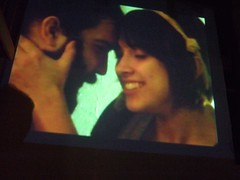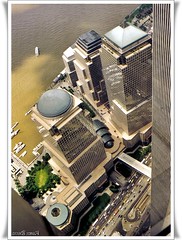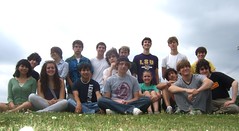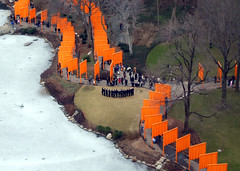Philippe Petit shifted his weight from his left foot, which was on the edge of the top of the World Trace Center's North Tower, to his right foot, which folded over the thick wire that he and his accomplices had painstakingly and secretly suspended between the twin towers. One of mankind's most glorious ventures had begun. The amazing walk of Petit on a wire strung between the towers of the World Trade Center took place in 1974. The documentary that revisits his feat, Man On Wire, was produced in 2008.
An award-winning movie of some 94 minutes, Man on Wire effectively blends footage of Petit at home in Paris - on a unicycle, with top hat - with footage of the construction of the WTC. He and his partners watched the completion of the towers as though they were terrorists. Through a torturous night in which the conspirators had to hide from the building's guards, the viewer emerges with Petit on a muggy morning in August in which the feat took place. The film of his dance on the wire above NYC is bellspinding.
Man on Wire is a highly recommendable movie, for it shows us a man who lives for adventure. Monsieur Petit, an athlete who is a spitfire and philosopher, challenges his viewers to move to the edge of our comfort zones.
Sunday, May 23, 2010
Semester exam: Van Gogh, Andy Goldsworthy, Patrick Dougherty, Christo, Phillipe Petit
In keeping with the semester's work, there will be two sections to the exam:
a) multiple choice, open notes.
Print out notes on these topics: Van Gogh, Andy Goldsworthy, Patrick Dougherty, Phillipe Petit.
b) comparison essay (choose one topic and write a draft in advance of the exam)
- Andy Goldsworthy & Phillipe Petit
- Vincent Van Gogh & Christo
- Alvin Ailey & Patrick Dougherty
Please bring notes on the topic or a draft of the essay . . .
a) multiple choice, open notes.
Print out notes on these topics: Van Gogh, Andy Goldsworthy, Patrick Dougherty, Phillipe Petit.
b) comparison essay (choose one topic and write a draft in advance of the exam)
- Andy Goldsworthy & Phillipe Petit
- Vincent Van Gogh & Christo
- Alvin Ailey & Patrick Dougherty
Please bring notes on the topic or a draft of the essay . . .
Monday, May 17, 2010
Award-winning documentary Man on Wire
Man on Wire is a 2008 documentary film directed by James Marsh. The film chronicles Philippe Petit's 1974 high-wire walk between the Twin Towers of New York's World Trade Center. It is based on Philippe Petit's book, To Reach the Clouds, recently released in paperback with the new title Man on Wire. The title of the movie is taken from the police report that led to the arrest (and later release) of Petit, whose performance had lasted for almost one hour. The film is crafted like a heist film, presenting rare footage of the preparations for the event and still photographs of the walk, alongside reenactments (with Paul McGill as the young Petit) and present-day interviews with the participants.
It competed in the World Cinema Documentary Competition[1] at the 2008 Sundance Film Festival, where it won the Grand Jury Prize: World Cinema Documentary and the World Cinema Audience Award: Documentary.[2] In February 2009, the film won the BAFTA for Outstanding British Film, the Independent Spirit Awards and the Academy Award for Best Documentary.
It competed in the World Cinema Documentary Competition[1] at the 2008 Sundance Film Festival, where it won the Grand Jury Prize: World Cinema Documentary and the World Cinema Audience Award: Documentary.[2] In February 2009, the film won the BAFTA for Outstanding British Film, the Independent Spirit Awards and the Academy Award for Best Documentary.
Looking down from the WTC in 1974 upon Lower Manhattan, New York
Walking on Air Between the Towers
By A. O. SCOTT
Published: July 25, 2008
On the morning of Aug. 7, 1974, after months of preparation and years of dreaming, a French daredevil named Philippe Petit stepped into the sky above Lower Manhattan. For almost 45 minutes he ambled back and forth on a metal cable strung between the towers of the World Trade Center, a feat of illegal tightrope walking that, according to a New York Police Department sergeant who recounted Mr. Petit’s act of physical poetry in dry press-conference prose, would more aptly be described as dancing.
For many years after, Mr. Petit’s stunt was a cherished footnote in the annals of New York history, one of the touchstones of a crazy, awful, glittering era in the life of the city. The destruction of the twin towers in the terrorist attacks of Sept. 11, 2001, revived the memory of that earlier aesthetic assault on the buildings, which is now the subject of “Man on Wire,” James Marsh’s thorough, understated and altogether enthralling documentary. Wisely, Mr. Marsh, who based his film on a book Mr. Petit published in 2002, never alludes to Sept. 11. That would have been both distracting and redundant, since it’s impossible, while watching a movie so intimate in its attention to the towers, not to be haunted by thoughts of their fate.
But it is also worth recalling that the trade center inspired more love posthumously than while it stood. Mr. Petit was an exception. A zealous, daring wire walker — the French word funambule is a more lyrical, as well as a somewhat more ridiculous-sounding term — he conceived a passion for the structures even before they were built.
As he recalls it (and as Mr. Marsh imagines the scene in one of many witty, unobtrusive re-enactments), the young Mr. Petit was flipping through a magazine at a doctor’s office when he saw an article about plans to construct the two tallest skyscrapers in the world side by side at the bottom of Manhattan. In his mind, and then in a series of sketches and diagrams, he drew a simple line connecting the buildings and imagined himself perched atop it.
What kind of person would think of such a thing? How would he go about accomplishing it? Why? Those are the questions that preoccupy Mr. Marsh, whose earlier films include the semidocumentary “Wisconsin Death Trip” and the fictional feature “The King.”
The first question is answered largely by Mr. Petit’s own testimony. In his 50s, he is elfin and energetic, a beguiling combination of showboat, idealist and con man. And in his early, outlaw years, before the twin towers walk brought him fame and a measure of legitimacy, he combined an exalted sense of artistic mission with a street criminal’s sense of serious mischief.
Accordingly, “Man on Wire” is constructed like a heist movie, in the manner of “Rififi” or the revived “Ocean’s Eleven” franchise. Though Mr. Petit was alone on the cable that August morning, his walk in the sky was the result of a conspiracy of true believers and casual adventurers. In his two previous acts of guerrilla funambulism — at the Cathedral of Notre-Dame in Paris and on the Harbor Bridge in Sydney — he relied on the logistical and moral support of several friends, including his lover, Annie Allix, and his faithful sidekick, Jean-Louis Blondeau.
In interviews, they and some of Mr. Petit’s other confederates — including two American goofballs and Barry Greenhouse, a flamboyant insurance executive who served as the all-important inside man — reconstruct their project, which they referred to at the time as “the coup,” in fascinating detail. There were engineering problems and also challenges that seem to belong to the world of espionage, as well as the inevitable tensions that arise when a group of people pursue a dangerous goal.
Why did they do it? Rather than risking banality by addressing this question head-on, Mr. Marsh allows the answer to be at once self-evident and profoundly mysterious. A work of art is its own explanation, and “Man on Wire” leaves no doubt that Mr. Petit’s coup deserves to be called art. Mr. Blondeau, a sensitive and cerebral foil to the impish Mr. Petit, chokes up when he recalls watching his friend step out over the abyss. “The important thing is that we did it,” he says.
And without making any grandiose claims, this lovely, touching film demonstrates that the World Trade Center sky walk was an important event. The proof is in the emotions — amusement, amazement, awe — evoked by those images of a tiny human figure balancing above a void. Also gratitude. It is easy to imagine that, in contemplating the scale and solidity of those brand-new towers, Mr. Petit saw them at least partly as the vehicle of his own immortality (whether or not he survived the crossing). No one looking up at the New York sky on a hazy morning 34 years ago and seeing a man on a wire could have suspected that the reverse would turn out to be true.
“Man on Wire” is rated PG-13 (Parents strongly cautioned). It includes nudity, sexuality and drug references.
By A. O. SCOTT
Published: July 25, 2008
On the morning of Aug. 7, 1974, after months of preparation and years of dreaming, a French daredevil named Philippe Petit stepped into the sky above Lower Manhattan. For almost 45 minutes he ambled back and forth on a metal cable strung between the towers of the World Trade Center, a feat of illegal tightrope walking that, according to a New York Police Department sergeant who recounted Mr. Petit’s act of physical poetry in dry press-conference prose, would more aptly be described as dancing.
For many years after, Mr. Petit’s stunt was a cherished footnote in the annals of New York history, one of the touchstones of a crazy, awful, glittering era in the life of the city. The destruction of the twin towers in the terrorist attacks of Sept. 11, 2001, revived the memory of that earlier aesthetic assault on the buildings, which is now the subject of “Man on Wire,” James Marsh’s thorough, understated and altogether enthralling documentary. Wisely, Mr. Marsh, who based his film on a book Mr. Petit published in 2002, never alludes to Sept. 11. That would have been both distracting and redundant, since it’s impossible, while watching a movie so intimate in its attention to the towers, not to be haunted by thoughts of their fate.
But it is also worth recalling that the trade center inspired more love posthumously than while it stood. Mr. Petit was an exception. A zealous, daring wire walker — the French word funambule is a more lyrical, as well as a somewhat more ridiculous-sounding term — he conceived a passion for the structures even before they were built.
As he recalls it (and as Mr. Marsh imagines the scene in one of many witty, unobtrusive re-enactments), the young Mr. Petit was flipping through a magazine at a doctor’s office when he saw an article about plans to construct the two tallest skyscrapers in the world side by side at the bottom of Manhattan. In his mind, and then in a series of sketches and diagrams, he drew a simple line connecting the buildings and imagined himself perched atop it.
What kind of person would think of such a thing? How would he go about accomplishing it? Why? Those are the questions that preoccupy Mr. Marsh, whose earlier films include the semidocumentary “Wisconsin Death Trip” and the fictional feature “The King.”
The first question is answered largely by Mr. Petit’s own testimony. In his 50s, he is elfin and energetic, a beguiling combination of showboat, idealist and con man. And in his early, outlaw years, before the twin towers walk brought him fame and a measure of legitimacy, he combined an exalted sense of artistic mission with a street criminal’s sense of serious mischief.
Accordingly, “Man on Wire” is constructed like a heist movie, in the manner of “Rififi” or the revived “Ocean’s Eleven” franchise. Though Mr. Petit was alone on the cable that August morning, his walk in the sky was the result of a conspiracy of true believers and casual adventurers. In his two previous acts of guerrilla funambulism — at the Cathedral of Notre-Dame in Paris and on the Harbor Bridge in Sydney — he relied on the logistical and moral support of several friends, including his lover, Annie Allix, and his faithful sidekick, Jean-Louis Blondeau.
In interviews, they and some of Mr. Petit’s other confederates — including two American goofballs and Barry Greenhouse, a flamboyant insurance executive who served as the all-important inside man — reconstruct their project, which they referred to at the time as “the coup,” in fascinating detail. There were engineering problems and also challenges that seem to belong to the world of espionage, as well as the inevitable tensions that arise when a group of people pursue a dangerous goal.
Why did they do it? Rather than risking banality by addressing this question head-on, Mr. Marsh allows the answer to be at once self-evident and profoundly mysterious. A work of art is its own explanation, and “Man on Wire” leaves no doubt that Mr. Petit’s coup deserves to be called art. Mr. Blondeau, a sensitive and cerebral foil to the impish Mr. Petit, chokes up when he recalls watching his friend step out over the abyss. “The important thing is that we did it,” he says.
And without making any grandiose claims, this lovely, touching film demonstrates that the World Trade Center sky walk was an important event. The proof is in the emotions — amusement, amazement, awe — evoked by those images of a tiny human figure balancing above a void. Also gratitude. It is easy to imagine that, in contemplating the scale and solidity of those brand-new towers, Mr. Petit saw them at least partly as the vehicle of his own immortality (whether or not he survived the crossing). No one looking up at the New York sky on a hazy morning 34 years ago and seeing a man on a wire could have suspected that the reverse would turn out to be true.
“Man on Wire” is rated PG-13 (Parents strongly cautioned). It includes nudity, sexuality and drug references.
Thursday, May 13, 2010
Fine Arts Survey Magnet Shreveport 2010
A certain number of the human beings in our class are seniors, which I believe means they're over age 55. Anyway, they're graduating. And we wish them well. They have been splendid respondents and comrades.
They are:
Alex Blandin, Lindsey Anderson, Matthew Collins, Hannah Connors, Cavett Feazel, Alex Jobe, Davis Knight, Andy Koerner, Lauren Monroe, Zach Provenza, Alexis Quiller, Lindsay Runge, Kyle Schuler, Kelly Sexton, Andrew Smith, Tyler Snelling and Jonathan Weber.
Bon voyage, mes amis!
They are:
Alex Blandin, Lindsey Anderson, Matthew Collins, Hannah Connors, Cavett Feazel, Alex Jobe, Davis Knight, Andy Koerner, Lauren Monroe, Zach Provenza, Alexis Quiller, Lindsay Runge, Kyle Schuler, Kelly Sexton, Andrew Smith, Tyler Snelling and Jonathan Weber.
Bon voyage, mes amis!
Thursday, May 6, 2010
Environmental artists Christo & Jeanne-Claude: Central Park NYC Gates
Christo (born Christo Vladimirov Javacheff, Bulgarian: 1935) and Jeanne-Claude (born Jeanne-Claude Denat de Guillebon, 1935 – November 18, 2009) were a married couple who created environmental works of art, says Wikipedia.
Their works include the wrapping of the Reichstag in Berlin and the Pont-Neuf bridge in Paris, the 24-mile-long artwork called Running Fence in Sonoma and Marin counties in California, and The Gates in New York City's Central Park.
Although their work is visually impressive and often controversial as a result of its scale, the artists have repeatedly denied that their projects contain any deeper meaning than their immediate aesthetic. The purpose of their art, they contend, is simply to create works of art or joy and beauty and to create new ways of seeing familiar landscapes.
Art critic David Bourdon has described Christo's wrappings as a "revelation through concealment."[3]To his critics Christo replies, "I am an artist, and I have to have courage ... Do you know that I don't have any artworks that exist? They all go away when they're finished. Only the preparatory drawings, and collages are left, giving my works an almost legendary character.
I think it takes much greater courage to create things to be gone than to create things that will remain."[4]
Their works include the wrapping of the Reichstag in Berlin and the Pont-Neuf bridge in Paris, the 24-mile-long artwork called Running Fence in Sonoma and Marin counties in California, and The Gates in New York City's Central Park.
Although their work is visually impressive and often controversial as a result of its scale, the artists have repeatedly denied that their projects contain any deeper meaning than their immediate aesthetic. The purpose of their art, they contend, is simply to create works of art or joy and beauty and to create new ways of seeing familiar landscapes.
Art critic David Bourdon has described Christo's wrappings as a "revelation through concealment."[3]To his critics Christo replies, "I am an artist, and I have to have courage ... Do you know that I don't have any artworks that exist? They all go away when they're finished. Only the preparatory drawings, and collages are left, giving my works an almost legendary character.
I think it takes much greater courage to create things to be gone than to create things that will remain."[4]
Wednesday, May 5, 2010
British sculptor, photographer and environmentalist Andy Goldsworthy: fine art via rocks, mud and ice
Andy Goldsworthy (born 1956) is a British sculptor, photographer and environmentalist living in Scotland who produces site-specific sculpture and land art situated in natural and urban settings.
His art involves the use of natural and found objects, says Wikipedia, to create both temporary and permanent sculptures which draw out the character of their environment.
The materials used in Andy Goldsworthy's art often include brightly-coloured flowers, icicles, leaves, mud, pinecones, snow, stone, twigs, and thorns. He has been quoted as saying, "I think it's incredibly brave to be working with flowers and leaves and petals. But I have to: I can't edit the materials I work with. My remit is to work with nature as a whole."[7]
Goldsworthy is generally considered the founder of modern rock balancing. For his ephemeral works, Goldsworthy often uses only his bare hands, teeth, and found tools to prepare and arrange the materials; however, for his permanent sculptures like "Roof", "Stone River" and "Three Cairns", "Moonlit Path" (Petworth, West Sussex, 2002) and "Chalk Stones" in the South Downs, near West Dean, West Sussex he has also employed the use of machine tools.
To create "Roof", Goldsworthy worked with his assistant and five British dry-stone wallers, who were used to make sure the structure could withstand time and nature.
Photography plays a crucial role in his art due to its often ephemeral and transient state.
His art involves the use of natural and found objects, says Wikipedia, to create both temporary and permanent sculptures which draw out the character of their environment.
The materials used in Andy Goldsworthy's art often include brightly-coloured flowers, icicles, leaves, mud, pinecones, snow, stone, twigs, and thorns. He has been quoted as saying, "I think it's incredibly brave to be working with flowers and leaves and petals. But I have to: I can't edit the materials I work with. My remit is to work with nature as a whole."[7]
Goldsworthy is generally considered the founder of modern rock balancing. For his ephemeral works, Goldsworthy often uses only his bare hands, teeth, and found tools to prepare and arrange the materials; however, for his permanent sculptures like "Roof", "Stone River" and "Three Cairns", "Moonlit Path" (Petworth, West Sussex, 2002) and "Chalk Stones" in the South Downs, near West Dean, West Sussex he has also employed the use of machine tools.
To create "Roof", Goldsworthy worked with his assistant and five British dry-stone wallers, who were used to make sure the structure could withstand time and nature.
Photography plays a crucial role in his art due to its often ephemeral and transient state.
ArtSpace Shreveport: Patrick Dougherty sculpture
Combining his carpentry skills with his love of nature, says the site stickwork.net, Patrick Dougherty began to learn about primitive techniques of building and to experiment with tree saplings as construction material.
Beginning about 1980 with small works, fashioned is his backyard, he quickly moved from single pieces on conventional pedestals to monumental site-specific installations that require sticks by the truckload.
To date he has built over two hundred such massive sculptures all over the world.
His home base is his handmade house of log in Chapel Hill, NC where he lives with his wife Linda and son Sam.
See video here.
Beginning about 1980 with small works, fashioned is his backyard, he quickly moved from single pieces on conventional pedestals to monumental site-specific installations that require sticks by the truckload.
To date he has built over two hundred such massive sculptures all over the world.
His home base is his handmade house of log in Chapel Hill, NC where he lives with his wife Linda and son Sam.
See video here.
Tuesday, May 4, 2010
Once the exercise of NYC dancers & actors: Pilates
Pilates (pronounced /pɨˈlɑːtiːz/) is a physical fitness system developed in the early 20th century by Joseph Pilates in Germany.[1] As of 2005, there are 11 million people who practice the discipline regularly and 14,000 instructors in the United States.[2]
Pilates called his method Contrology (from control and Greek -λογία, -logia), because he believed his method uses the mind to control the muscles.[1] The program focuses on the core postural muscles which help keep the body balanced and which are essential to providing support for the spine. In particular, Pilates exercises teach awareness of breath and alignment of the spine, and aim to strengthen the deep torso muscles.
Pilates called his method Contrology (from control and Greek -λογία, -logia), because he believed his method uses the mind to control the muscles.[1] The program focuses on the core postural muscles which help keep the body balanced and which are essential to providing support for the spine. In particular, Pilates exercises teach awareness of breath and alignment of the spine, and aim to strengthen the deep torso muscles.
Monday, May 3, 2010
Postmodern patterns in architecture; do they include the Magnet PAC?
Postmodernism, as described by Wikipedia: does it affirm the Magnet PAC as a postmodern design?
In the last quarter of the 20th century some architects started to turn away from modern Functionalism (Magnet campus proper) which they viewed as boring, and which some of the public considered unwelcoming and even unpleasant.
These architects turned towards the past, quoting past aspects of various buildings and melding them together (even sometimes in an inharmonious manner) to create a new means of designing buildings.
A vivid example of this new approach was that Postmodernism saw the comeback of pillars and other elements of premodern designs, sometimes adapting classical Greek and Roman examples (but not simply recreating them, as was done in neoclassical architecture). As in Magnet's Doric columns in the porticos.
In Modernism, the pillar (as a design feature) was either replaced by other technological means such as cantilevers, or masked completely by curtain wall façades.
The revival of the pillar was an aesthetic, rather than a technological, necessity. Modernist high-rise buildings had become in most instances monolithic, rejecting the concept of a stack of varied design elements for a single vocabulary from ground level to the top, in the most extreme cases even using a constant "footprint" (with no tapering or "wedding cake" design), with the building sometimes even suggesting the possibility of a single metallic extrusion directly from the ground, mostly by eliminating visual horizontal elements — this was seen most strictly in Minoru Yamasaki's World Trade Center buildings.
In the last quarter of the 20th century some architects started to turn away from modern Functionalism (Magnet campus proper) which they viewed as boring, and which some of the public considered unwelcoming and even unpleasant.
These architects turned towards the past, quoting past aspects of various buildings and melding them together (even sometimes in an inharmonious manner) to create a new means of designing buildings.
A vivid example of this new approach was that Postmodernism saw the comeback of pillars and other elements of premodern designs, sometimes adapting classical Greek and Roman examples (but not simply recreating them, as was done in neoclassical architecture). As in Magnet's Doric columns in the porticos.
In Modernism, the pillar (as a design feature) was either replaced by other technological means such as cantilevers, or masked completely by curtain wall façades.
The revival of the pillar was an aesthetic, rather than a technological, necessity. Modernist high-rise buildings had become in most instances monolithic, rejecting the concept of a stack of varied design elements for a single vocabulary from ground level to the top, in the most extreme cases even using a constant "footprint" (with no tapering or "wedding cake" design), with the building sometimes even suggesting the possibility of a single metallic extrusion directly from the ground, mostly by eliminating visual horizontal elements — this was seen most strictly in Minoru Yamasaki's World Trade Center buildings.
Sunday, May 2, 2010
Have 4 Art Experience essays filed in Google Docs; label them by month, please
Please label them in your Google Doc account -
- Jan
- Feb
- March
- April
15 pts each.
Though they need not be lengthy, they must be detailed.
- Colorful, descriptive opening (5 pts)
"Yeaaagh" shouted Roger Peterson at the climax of the Spring Season One-Acts at Magnet. As an actor in a Monty Python script, he'd been shot dead by his wily instructor in martial arts and defense against fruit, played by Terry Tucker.
- Generalities followed by descriptive detail (5 pts).
While four of the plays were comic, the one entitled "A World Without Memory" was a sober, touching exploration of the onset of Alzheimer's; the aged man was capably played by Jonathan Weber.
- Evaluation and Balance - describing both the laudable as well as disappointing (5 pts)
Cues and lines seemed tight in 3 of the plays. The closing piece, "Check, Please" was uneven. On the one hand, there were stellar moments from animated actresses Michelle Khare and Elissa Little. There were also miscues; the overall pacing was uneven. The audience was responsive, if small in number. Is the Drama Dept advertising its work adequately?
- Basic info (3 pts)
One-Act Magnet Drama Dept performances of four plays on Ap 30 in the PAC involving some 20 actors and a 7-person production team. Directed by six students: Mickey DeLucia, Madison Edwards, Jessica Hensley, Hunter Ward, Elissa Little and Gentry Williams. Caddo Magnet drama teacher is Mrs Patti Reeves.
You may write about . . .
- an opera, orchestra concert, play or
- about eating at an ethnic cuisine restaurant - Thai, Indian or Japanese, for ex. - or
- an indie movie that is approved by your teacher.
(No more than 2 of the 4 essays may be on movies.)
- also, an art exhibit at a gallery or museum.
- Jan
- Feb
- March
- April
15 pts each.
Though they need not be lengthy, they must be detailed.
- Colorful, descriptive opening (5 pts)
"Yeaaagh" shouted Roger Peterson at the climax of the Spring Season One-Acts at Magnet. As an actor in a Monty Python script, he'd been shot dead by his wily instructor in martial arts and defense against fruit, played by Terry Tucker.
- Generalities followed by descriptive detail (5 pts).
While four of the plays were comic, the one entitled "A World Without Memory" was a sober, touching exploration of the onset of Alzheimer's; the aged man was capably played by Jonathan Weber.
- Evaluation and Balance - describing both the laudable as well as disappointing (5 pts)
Cues and lines seemed tight in 3 of the plays. The closing piece, "Check, Please" was uneven. On the one hand, there were stellar moments from animated actresses Michelle Khare and Elissa Little. There were also miscues; the overall pacing was uneven. The audience was responsive, if small in number. Is the Drama Dept advertising its work adequately?
- Basic info (3 pts)
One-Act Magnet Drama Dept performances of four plays on Ap 30 in the PAC involving some 20 actors and a 7-person production team. Directed by six students: Mickey DeLucia, Madison Edwards, Jessica Hensley, Hunter Ward, Elissa Little and Gentry Williams. Caddo Magnet drama teacher is Mrs Patti Reeves.
You may write about . . .
- an opera, orchestra concert, play or
- about eating at an ethnic cuisine restaurant - Thai, Indian or Japanese, for ex. - or
- an indie movie that is approved by your teacher.
(No more than 2 of the 4 essays may be on movies.)
- also, an art exhibit at a gallery or museum.
Subscribe to:
Posts (Atom)














